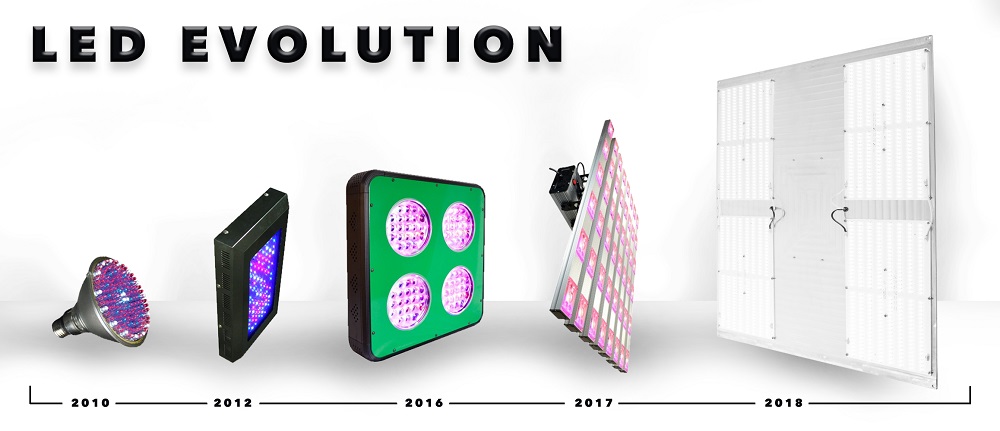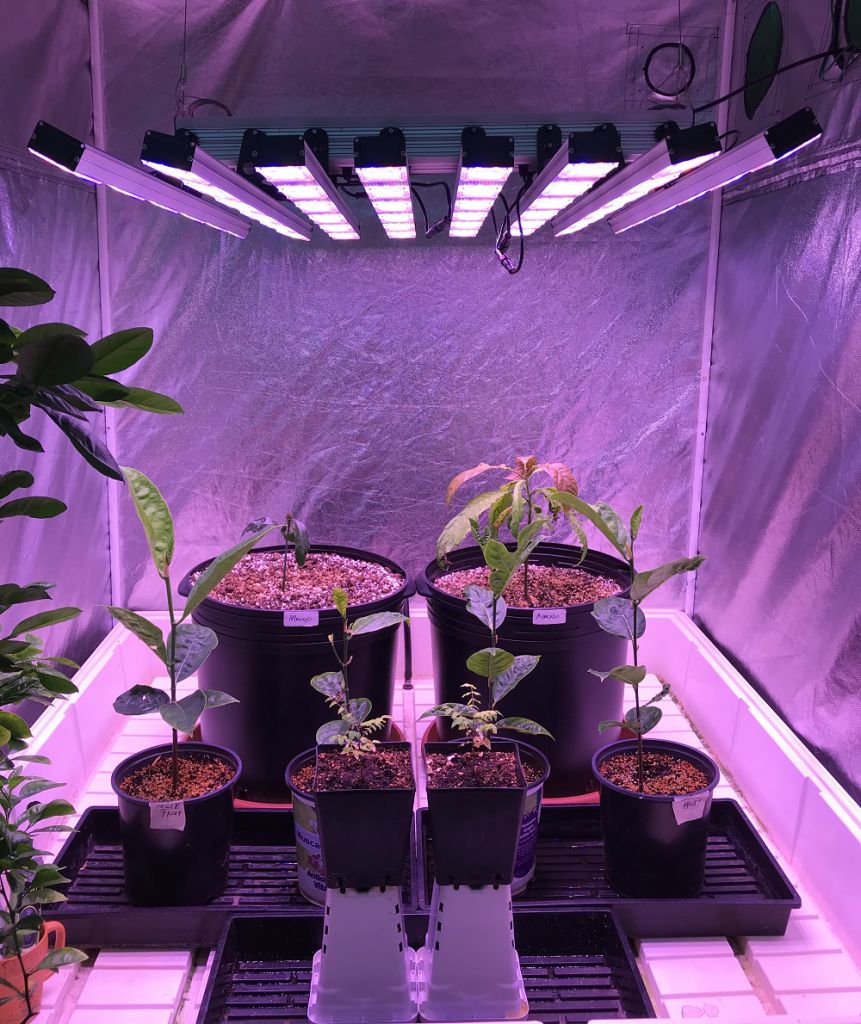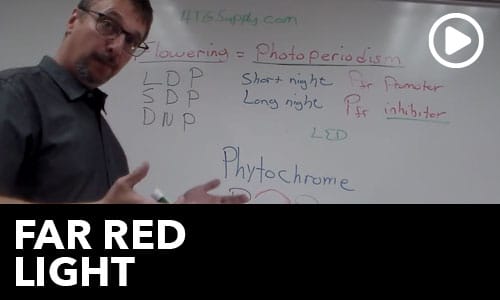Rewind back to 2012. The world is about to end, Obama just got re-elected, and “Call Me Maybe” by Carly Rae Jepsen is topping the charts. Everyone is using their iPhone 5’s to tweet about Michael Phelps winning his 18th gold, and LED grow lights are in their infancy with bulky red and blue UFOs hovering in grow tents everywhere.
Today, LED technology provides the newest advances in lighting, and this is still a rapidly advancing area for indoor growing. As the technology has improved, we’ve seen a wide variety of new types of LED grow lights hit the market, especially in the last 5-6 years. With the evolution of more efficient LED chips, once rare features such as passive heat sinks, full-spectrum boards, SMD and COB LEDs, and programmable spectrum LEDs are becoming common. In this Talking Shop Segment, we’ll give you an inside look at how recent advancements in LED grow light technology are changing the industry. Plus, read through for our featured coupon to save on the latest LEDs!

New Manufacturing & Design
Before we dive right into the high-tech LED jargon, let’s take a quick look at the basics of an LED to for anyone who might be unfamiliar. The abbreviation ‘LED’ stands for light emitting diode, which is essentially an electronic component that creates light by passing current through a semiconductor material. The earliest LEDs were simple devices that created a small amount of light, and until just a few years ago, most were similar in design to the basic LEDs shown in the diagram and image here.
Surface Mount Diode – SMD
Surface Mount Diode, or SMD, is quickly becoming the new standard for LED lighting. To understand SMDs in context, first let’s look at the LEDs that came before. If you think of an LED, you probably imagine a bulbous plastic shell with two wires sticking out like the diagram above, those are called Dual-Inline-Package (DIP). These LEDs utilized through-hole technology (because the wires on a component were put through the holes in a circuit board), and is still used today to mount large pieces, like transformers and some semiconductors. SMD LEDs main difference is the way in which they are attached to circuit boards. Instead of being put through open holes in the circuit board, SMDs are soldered directly to the surface of the circuit board.
Fixtures with SMDs can be produced faster, as machines are able to do the mounting and soldering. SMDs don’t have the resin light diffuser covering the diode giving the chip a more consistent light beam angle, and their small size enables compact placement on circuit boards. These technological evolutions in tandem have led to lower SMD LED prices, more compact LED panels, and less light loss among the LED chips themselves.
One of the distinct features of SMD LED chips is the number of contacts and diodes they have. SMD LED chips can have more than just two contacts (which makes it different from the classic DIP LED). There can be up to 3 diodes on a single chip, with each diode having an individual circuit. Each circuit would have one cathode and one anode, leading to 2, 4 or 6 contacts in a chip. This configuration is what makes SMD LEDs more powerful and versatile than previous generations. For most grow lights, all three diodes will be either narrow spectrum red/blue or full spectrum white to maximize the horticultural output of any given fixture. However, this technology is also used to make red/blue/green (RGB) LEDs, the that can be set to virtually any color by adjusting individual diode output levels. SMD LEDs are the standard in grow fixtures today, and moving forward they’ll only become more efficient.
Chip on Board – COB
Chip on Board, otherwise known as COB, is a variant of basic LEDs where multiple (usually more than 10) are mounted in a tight cluster on a single module. This creates several unique advantages to COB LEDs, there’s more output per unit, fewer components for a lower failure rate, less light loss, and more efficient heat dissipation.
Unlike SMD, COB LED lights can’t be used to create color changing bulbs or lights. This is because there are only 2 contacts and 1 circuit. Multiple channels for adjustment are required to create the color changing effect. COB LED grow lights show their true superiority in their use of energy, and they’re known for better PPF-per-watt ratios as well as heat efficiency thanks in large part to the cooling ceramic substrate of the chips. This has led to the proliferation of LEDs into heavy duty lighting, such as spotlights and floodlights.
COB LEDs are, for the most part, used for bright white light in grow lights. Because of the single-color requirement, many manufacturers chose to double down on the COB’s efficiency by utilizing white chips instead of red or blue. In fact, it’s not uncommon for fixtures to have a blend of white COBs and red and blue SMDs. On top of that, many fixtures with COB LEDs require active cooling components, reason being that COBs, while generating less heat per watt than SMDs, still put out more total heat.
T5 LEDs – Fluorescent Retrofit
T5 LEDs are a recent innovation in fluorescent fixtures. T5 fixtures are standard in many gardener’s setups, where they’re prized for their efficiency, low cost, and low heat output. Mainly used for seed starting, seedlings, over-wintering, mother-keeping, and for plants that do not require powerful light like herbs and small flowers, T5 setups have been complimenting gardens for decades. It’s the same type of lighting that’s probably in your office or apartment building right now (unless your landlord has upgraded to LEDs). T5 LED bulbs can be used as direct replacements for fluorescent bulbs, with no modifications to ballasts or sockets necessary. This gives a twofold advantage to gardeners, you’re able to save on power costs and boost light output in your current fluorescent fixture, plus there is no need to reconfigure your garden setup, just swap out the old bulbs for the new.
T5 LEDs also provide superior durability versus traditional fluorescent bulbs. Anyone who’s ever dropped a T5 and felt that slow-motion despair as the bulb fell to the ground and shattered, tossing glass everywhere, knows what I’m talking about. With a glass-free construction, T5 LEDs are shatterproof. On top of that, T5 LEDs are much more easily recycled than glass bulbs. Durability is also a factor for the lifetime of your bulbs. LED T5s operate at a lower wattage than traditional bulbs and have a 50,000 hour rated lifespan, 30-40,000 hours longer than fluorescent bulbs, eliminating the need to replace your fluorescent tubes yearly. In total, T5 LEDs are a standout evolution in LED technology, and should quickly replace fluorescent technology in the indoor horticulture world.
Horticultural Spectrum Advances
Full Spectrum LEDs
Some grow light manufacturers have been swapping narrow-band red and blue LEDs for full-white LEDs, leading to the advent of full spectrum LED grow lights. White light, as opposed to any other color light, contains all wavelengths of visible light between 400-700nm. White light is also more like sunlight or natural than fixtures using only blue and red LEDs, and still provides the red and blue bands in the photosynthetically active region of the visible spectrum. Additionally, manufacturers are combining white COBs with narrow-band SMDs to create light output that benefits from the broad white spectrum with boosts to key red and blue wavelengths.
The key driver behind all-white LED fixtures is the efficiency of white LED chips in terms of the amount of light they put out, which is best measured in micromoles per watt (µmol/watt). While red/blue LEDs currently peak around 1.6-1.9 µmol/watt, the best white LEDs peak at about 2.3-2.5 µmol/watt. Although full-spectrum white LEDs aren’t directly targeted to specific photosynthetic wavelengths, their overall output efficiency more than makes up for the difference.
Supplemental Far Red LEDs
Light does more than provide a source of energy to plants. Light is also important in regulating plant flowering. The amount of far red light is responsible for when some plants flower. While not all plants are dependent on far red light to promote flowering, plants that do respond to far red light are either short day or long day plants. Short day plants flower when the night is longer than 12 hours long, usually in early spring or fall. Long day plants flower in the summer when the nights are longest. If you are growing a short day plant, then you can increase the flowering response by giving your plants far red light. You should start off giving you plant far red light for 20 min before the night cycle. You have to be careful not to give plants too much far red light as this might stress them out. If you give your plants far red light in addition to a 12 hour night, you will notice flowering time is shorter with a faster flowering response.
Programmable LED Systems
Smart fixtures. Everything is smart today. Smartphone, smartwatch, smart people. Custom spectrum LEDs give growers the ability to manipulate their plants’ growth as a response to the light spectrum, control on/off cycles with the fixture, simulate sunup and sunset, and better regulate fixture heat output.
Controlling spectrums is the primary advantage growers get form using customizable fixtures. Red light will trigger flowering as well as stem elongation by increasing the internode spacing in your plant, while Blue light reduces internode spacing and causes compact, bushy growth. Using a customizable fixture, a grower can set the light spectrum to match the plant’s life cycle. You would use more blue for vegetative growth and have more red during the flowering cycle.
The primary drawback to customizable LEDs is the loss in total output. For example, if you have a fixture with white, blue, and red LEDs, the only way to change the spectrum to vegetative or flowering for now is to power off some of the red or blue LEDs, lowering the total light output of the fixture. Essentially, it’s a trade – a boost in custom spectrum but a loss total output. For growers who can afford this trade-off though, controlling spectrums gives you the best of both worlds, you can veg your plants with blue heavy light then swap to red heavy for a bushy bloom.
Future of LEDs
So what does the future hold for LED grow lights? As LEDs become more and more efficient, low-power/high-output fixtures will likely come to dominate the market. Scientific studies have demonstrated that for plants popular among indoor cultivators, effective light levels max out at 139.35 micromoles per square foot per second. In other words, eventually, adding more light will not create more growth. LED technology can currently hit these numbers, but it’s still expensive and still requires a high-power load (although still not as much as HIDs). What we expect to see in the future is more of what we are seeing now – LEDs becoming more powerful (higher µmol outputs), requiring less energy to operate, and shrinking in size and combine into new forms like COB LEDs.
There are already “Farms of the Future” popping up in urban areas that utilize high-efficiency LEDs to grow suitable hydroponic crops like lettuce, leafy greens, and micro greens. As cities continue to sprawl and the global population keeps booming; localized, high-efficiency, multi-tiered horticulture facilities will be vital in providing healthy and nutritious foods to city residents, especially disadvantaged and economically vulnerable populations. Currently, these hydroponic farms serve as more of a proof of concept for commercial cultivation more than actually replacing traditional agriculture, but thanks to LED technology, this could soon be a reality. New types of LED tech like SMD and COB, new fixture types like LED T5s and passive cooling panels, and new spectrum output are pushing the envelope as to what a grow light can be, and the future is looking bright.
____________________
Growing with LEDs? Join the conversation, and comment below! Throw a picture on Instagram and tag us in it (@HTGSupply) – we’d love to see your results! Don’t forget to check out this week’s coupon code and sale information as well! From all of us here, good luck, stay safe, and Happy Growing!

FEATURED COUPON CODE: TSLED1118Enter the promo code at checkout for a 5% discount on the top LEDs featured below or visit your local HTG Supply and simply mention this article to get the deal in-store! Thanks again for tuning into Talking Shop with HTG Supply! Offer valid through HTGSupply.com and in-store 11/01/18-12/31/18. Cannot be combined with other offers. Follow us on social media to learn more about indoor growing! Get all kinds of tips, tricks and techniques, and stay up to date all of our sales and events!



